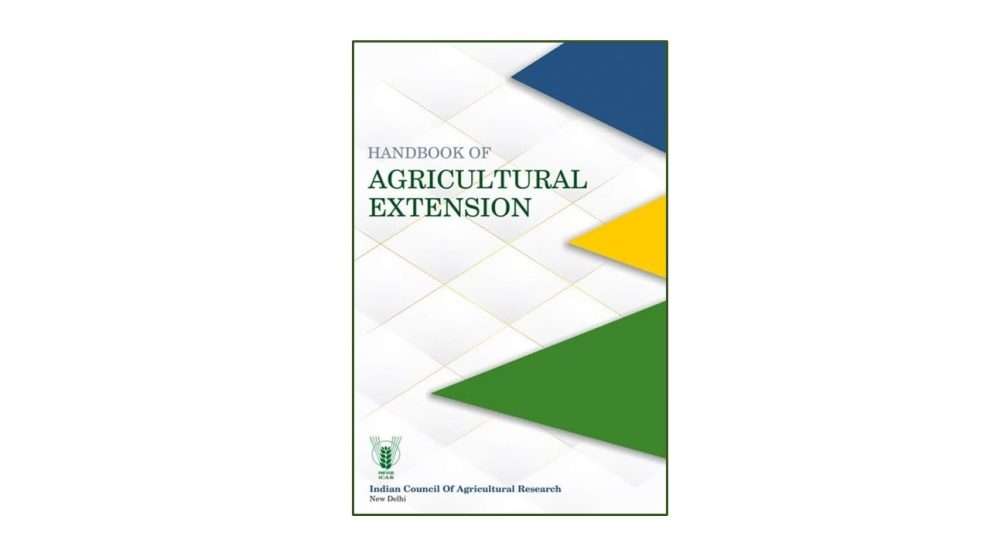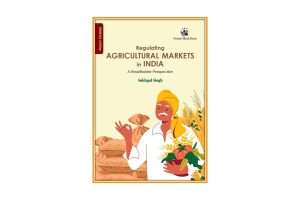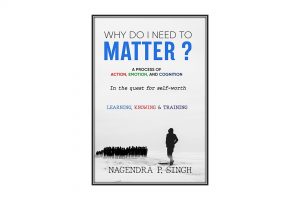Indian Council of Agricultural Research, New Delhi (2020)
ISBN: 9788171642076
Hardcover: Rs. 1000
Pages: 860
The Agricultural Extension Division of ICAR recently published a Handbook of Agricultural Extension. This massive volume divided into 22 chapters is expected to serve “as a ready reckoner and reference material for the extension fraternity including students, professionals and practitioners”.
In this edition of AESA Book Review, we publish three independent reviews of this publication written by Dr Sreeram Vishnu, Dr Bhuvana Rao and Dr Rasheed Sulaiman V.
REVIEW 1
 Agricultural Extension, arguably the youngest of the agricultural sciences evolved through creation, re-creation, adaptation, and integration over years. Identified as social innovation, its purpose was to build the competency of various actors in agriculture and stimulate appropriate behavioural changes that can help them adjust to dynamic societal needs. Though the origin of the word ‘extension’ can be traced back to educational settings, gradually the concept found more acceptability in the developmental discourse in agriculture. Unlike the other agricultural sciences which have strict disciplinary borders and well-defined roots for their body of knowledge, agricultural extension has more flexible boundaries and borrows its content heavily from related social science subjects. Knowledge from a variety of scientific fields such as communication, psychology, management, sociology, development studies, entrepreneurship, journalism, etc., are being assimilated into its core in this effort. A thorough understanding in these areas is important for any agriculture professional, as they are fundamental to the practice of agricultural science in various settings. Moreover, it attempts to capacitate the learners to fit into various roles by building their functional competencies. For these reasons, the subject is always included in the academic programmes of agricultural sciences, across the world.
Agricultural Extension, arguably the youngest of the agricultural sciences evolved through creation, re-creation, adaptation, and integration over years. Identified as social innovation, its purpose was to build the competency of various actors in agriculture and stimulate appropriate behavioural changes that can help them adjust to dynamic societal needs. Though the origin of the word ‘extension’ can be traced back to educational settings, gradually the concept found more acceptability in the developmental discourse in agriculture. Unlike the other agricultural sciences which have strict disciplinary borders and well-defined roots for their body of knowledge, agricultural extension has more flexible boundaries and borrows its content heavily from related social science subjects. Knowledge from a variety of scientific fields such as communication, psychology, management, sociology, development studies, entrepreneurship, journalism, etc., are being assimilated into its core in this effort. A thorough understanding in these areas is important for any agriculture professional, as they are fundamental to the practice of agricultural science in various settings. Moreover, it attempts to capacitate the learners to fit into various roles by building their functional competencies. For these reasons, the subject is always included in the academic programmes of agricultural sciences, across the world.
However, not many reading resources are visible that value this diversity, at least in the Indian context. Though there are good publications, most of them are limited in their scope, generally focused on only one of the specific dimensions of the discipline. Moreover, the demand is for contextualized books that integrate any specialized field of social science with agricultural science. The quality of the available resources is another major concern. Hence there is a long-felt need for such a comprehensive reference book for scholars, researchers and practitioners of this discipline. The Handbook of Agricultural Extension can be identified as an attempt to address this need. It attempts to broad base the subject by illustrating its wider scope and applicability. Through my review I have tried to examine the unique contributions of this book as well as to critique some of the shortcomings that could have been addressed.
The book starts with an effort to trace the lineage of agricultural extension in various countries including India. Significant events that marked the genesis of extension practice, education and research are discussed in this attempt. Though extension had a humble beginning in India, by centering on rural development and community development programmes, its focus gradually shifted towards technology mediation, development of agriculture by facilitating behavioural change, and capacitating various stakeholders including farmers. Furthermore, the structural transformation of the discipline in response to changing dynamics extended its scope to new areas – application of information and communication technology in farming, participatory methods, sustainable farming and institutional innovations. These changes also played a crucial role in making extension more demand led than the supply-driven approaches practiced until then.
Various initiatives of the Government of India and the Indian Council of Agricultural Research (ICAR), which had commenced during this period and characterized this transition are narrated in the book. The book tries to build on the body of existing knowledge in order to add more content. For instance, it tries to highlight the emergence of some new approaches, such as Farmer Field Schools, NGO-based extension, and private extension in addition to the eight extension approaches propounded by Axinn (1988).
The book has chapters exclusively dedicated to throwing insights on extension research that researchers may find very useful. It goes into detail on research processes, critical assumptions and concepts, approaches, theory building, research designs and guiding principles. Various psychometric scaling techniques and psychological tests – grounded in behavioural theories and advanced methods – are also discussed. These chapters may be considerably useful for beginners in framing research studies systematically and scientifically. Similarly, two chapters focus exclusively on management, which has implications on the conduct of agricultural administration. Agriculture professionals tasked with running organizations may find some of the topics such as management theories, methods, organizational management, project management techniques and motivational and leadership theories, quite interesting. However, real life case examples would have made the chapter more relevant and useful.
Likewise, participatory methods and approaches, the most effective and tested tools in designing and delivering inclusive developmental interventions, would be useful to development practitioners. Monitoring & Evaluation and Assessment of Extension Programmes is separately dealt with as a chapter. The book also presents the conventional tools such as Kirk Patricks’ model, Bennet’s hierarchy and Logical framework approach as well as the recent ones like Propensity Score Matching for objectively appraising interventions. Chapter 6, ‘Reaching farmer’s through innovative extension models’, needs special mention as it outlines the discipline’s gradual evolution from an educational approach to development facilitation. Given the emerging challenges in agriculture, the extension system has evolved novel mechanisms to address these. It includes models to strengthen technology outreach (National Demonstration, Operational Research Project, Krishi Vigyan Kendra), enhance better research extension connect (IVLP, Farmer First), and farmer-oriented participatory extension systems (ATMA). Further on, the chapter discusses the latest advances in this regard such as ARYA, a drive to attract youth to farming, Mera Gaon Mera Gourav, the ICAR-led village adoption scheme, the NICRA initiative to tackle challenges of climate change in agriculture, and VATICA, a programme to promote value addition and incubation training in agriculture. As a reader, I found these chapters quite informative. However, it may be mentioned that the book missed the chance to throw more light on some relevant topics such as the status and performance of ATMA, the much highlighted institutional innovation, or the recently launched National Mission on Agricultural Extension & Technology (NMEAT).
Some topics, such as extension communication for change management, extension teaching methods, agricultural journalism training and capacity building are dealt with in separate chapters. The book also has chapters dedicated to emerging areas of interest – gender and nutrition, entrepreneurship and agribusiness, intellectual property rights and knowledge management. This effort to present the many facets of extension must be appreciated.
Though the book is well-designed, repetition of content in some chapters can annoy the reader. For instance, theories of motivation are given in both the chapters dealing with agricultural extension management. Similarly, the birth of modern extension and advisory services is presented in the first chapter and then again in the sixth chapter. To continue, content in some chapters are limited to just the insights offered by seminal researchers in that topic. To specifically quote an example, in the chapter ‘Diffusion of Innovations’, content is confined to the arguments and postulates of Everett Rogers, though the discussion has progressed much further, moving beyond the linear transfer of technology paradigm. Given that the concepts of Agricultural Knowledge and Information Systems (AKIS) and Agricultural Innovation System (AIS) came to the fore subsequently to explain technology innovation and diffusion systems, such advances are not mentioned in this chapter.
Likewise, the chapters dealing with research methodology could have offered more insights on the various research strategies. As a source book in extension, a more detailed coverage of qualitative and mixed research methods was expected along with its applicability in various contexts like consumer and marketing studies, media research, policy analysis, etc. Are we appreciating the content diversity of the discipline while making the research framework of extension is a question that needs to be addressed. A systematic focus in this regard would have enriched this book substantially. Finally, a more balanced presentation of the content by grounding it on the contemporary issues and challenges faced by the discipline would have been even more appreciated by readers rather than the overarching focus on past experiences and conventional pathways followed by the discipline.
In summary the book integrates knowledge from various disciplinary portfolios that form the building blocks of agricultural extension. The content encompasses knowledge from both traditional fields and evolving areas of the discipline. Undoubtedly, the handbook is a first of its kind published in agricultural extension in India. The wealth of knowledge available in the book makes it a ready reference for extension students and faculty. It can also help students preparing for various competitive exams in the subject. But the same cannot be said for extension field practitioners who look for ways to enhance their capacities to solve field-level extension challenges.
Sreeram Vishnu
Dr Sreeram Vishnu, Assistant Professor (Agricultural Extension), Regional Agricultural Research Station (RARS), Ambalavayal, Wayanad, Kerala. He did his PhD in Agricultural Extension from ICAR-National Dairy Research Institute (NDRI), Karnal, Haryana and his Master’s in Agricultural Extension from the Acharya N G Ranga Agricultural University (ANGRAU), Andhra Pradesh. He can be reached at srieeram@gmail.com
REVIEW 2
 Agricultural Extension is a domain in the Social Sciences concerned with the application of science to educate and influence the behavior of people. The subject of Agriculture Extension is vast, cutting across the disciplines of agriculture, communication, psychology, behavioral sciences, organizational sciences, and journalism to name a few, and a comprehensive resource on the subject was scarce. Most of the available sources on wider disciplines of extension were either limited in scope or not comprehensive enough to be a complete guide for practitioners. In this backdrop, it is heartening that the Indian Council of Agricultural Research (ICAR) has released a handbook on Agricultural Extension with 22 chapters that attempts to cover the pluralistic nature of agricultural extension as a discipline.
Agricultural Extension is a domain in the Social Sciences concerned with the application of science to educate and influence the behavior of people. The subject of Agriculture Extension is vast, cutting across the disciplines of agriculture, communication, psychology, behavioral sciences, organizational sciences, and journalism to name a few, and a comprehensive resource on the subject was scarce. Most of the available sources on wider disciplines of extension were either limited in scope or not comprehensive enough to be a complete guide for practitioners. In this backdrop, it is heartening that the Indian Council of Agricultural Research (ICAR) has released a handbook on Agricultural Extension with 22 chapters that attempts to cover the pluralistic nature of agricultural extension as a discipline.
The book provides a foundation – encompassing the basic concepts, approaches and conceptual differences in extension – that is vital for all beginners. At the same time, the book also provides a historical perspective on important extension efforts along with a brief overview of emerging extension approaches such as FPOs, electronic National Agriculture Markets, Para professionalism, programme for input dealers (DAESI), climate smart extension, and other developments in the field of agriculture. The book also explicitly highlights the imminent need to revise the curriculum so as to align with the demands of present day agriculture (pages 30-31). It also refers to a few courses offered by universities abroad on subjects such as governance, livelihoods and resources, facilitating interactive processes and cutting edge issues in rural development and innovations, etc. It would have been even more useful if a few chapters were dedicated to these niche areas in extension that could also have acted as a blueprint for future changes in curricula.
The best part of the book, which fascinated me, is the way it highlights the different roles that an extensionist can perform. Topics such as management, communication, journalism, sociology, psychology, innovations, capacity building, adult education, ICT, media management are all taught as independent degree programmes in the traditional education system, but we, the students of agricultural extension, get to study all of them and the book provides good information on these topics succinctly, including the basic concepts, theories, and models. For an early-career researcher like me, if the chapters had been offered with specific topics together with case studies on the application of these theories and models under different conditions, it would have been more engaging while also giving a flavour of ground reality.
The book also discusses different approaches and innovative extension models used in different organizations – public, private, civil society – in different areas viz., educational, farming system, public private partnership (PPP), privatization approach, etc. In later editions of the book I would love to see the addition of more topics such as Agricultural Innovations Systems (AIS)/environmental extension/systems approach in extension/partnership approaches other than PPP, or learning modules developed by global organizations like FAO/GFRAS/ADB/CGIAR, recent updates to theories that examine farmers’ adoption behaviour (like theory of planned behaviour, theory of reasoned action, Technology Adoption Model), or use of behavioural experiments to understand farmers’ adoption process (biases, heuristics, etc.). These theories are frequently used in extension research across the globe and a comprehensive coverage of these could be of great help to both students and scholars to keep them abreast of recent developments.
Another very useful part of the book is the brief information given on tools and techniques, which is handy for extension researchers. The book covers a range of topics: project planning and management, participatory approaches and technology development, research designs and methods, psychometric methods, monitoring, evaluation and impact assessment methods. Proper methods in scientific research are absolutely essential for evidence-based policy formulation and the book introduces many methods and statistical tools for generating scientific evidence. The techniques presented are quite useful, especially for beginners who can then understand the context and provide an analytical and scientific outlook for the research/project work they want to plan and present.
Information and Communication Technology (ICT) is a trendsetting domain in the present era, as it has proven its potential to reach these technologies/information to large numbers of farmers – a verified method, especially during the pandemic. With advancement of technology, crop advisories, crop planning, weather, yield monitoring and predictions can be made available at your fingertips, which needs to be exploited by extension professionals. The book has dedicated a considerable part to dealing with ICT tools such as radio, TV, mobile phones. However, more emphasis on recent advances like internet of things (IoT), machine learning and artificial intelligence for faster transfer of technologies along with successful case studies (maybe from Krishi Vigyan Kendras [KVKs], State Agricultural Universities [SAUs], Agricultural Departments or any other development organizations) would have added greater value.
E-journalism is another section that I liked in the book and it will have a greater role to play in the days to come. The book highlights different techniques of editing and proofreading. This is the age of social media, and writing for social media platforms and newspapers is an important skill for an extension agent, but such information is very limited here. Expanding on these aspects, in addition to content development for broadcasting media, would have been helpful. The insights on entrepreneurship, gender and nutrition, agricultural laws, intellectual property rights, commercialization of technologies are the need of the hour and is well covered in this Handbook.
The lack of a comprehensive ready reckoner for the discipline of extension for students and teachers is bridged with this timely publication. Bringing out such a handbook is a Herculean task and the efforts of editors and authors are commendable. It will be very useful to all those who take an interest in agricultural extension. I hope to see constant revision and updated editions of the book incorporating latest advances in the science of Agricultural Extension. As it is said, change is the only constant – the science grows very fast and keeping pace with it is crucial to remain relevant.
Bhuvana N
Dr Bhuvana N is a Consultant, Centre for Research on Innovation and Science Policy (CRISP), Hyderabad, India. She earned her PhD in Agricultural Extension from the Professor Jayashankar Telangana State Agricultural University, Hyderabad. She holds double masters; Masters in Agricultural Extension from University of Agricultural Sciences, Bengaluru, India and Masters in Rural Development from University of Ghent, Belgium. She has research experience from Wageningen University, Netherlands. Her area of expertise is in the field of qualitative methods for social science research. You can reach her at bhuvana.rao7@gmail.com
REVIEW 3
 About thirty years back during my doctoral programme in agricultural extension (1990-93), I realized the duplication of content in the MSc and PhD extension curricula in extension. I was a bit disappointed at the lack of new and relevant content at the PhD level and being forced to learn the same content I had already learnt at the MSc level. In 1996 while working as an extension scientist with the Indian Council of Agricultural Research, I took the lead in organizing a consultation on extension curricula.[1] Later I wrote a paper with Prof A W van den Ban on the extension curricula in India[2] and its limitations, and how this is adversely affecting the job prospects of our students as well as the professional growth of scientists and practitioners of this discipline. While many appreciated those concerns, there hasn’t been any real move to address the difficult situation we are in. The problems were also presented in the 2018 AESA Discussion Paper on extension curricula.[3]
About thirty years back during my doctoral programme in agricultural extension (1990-93), I realized the duplication of content in the MSc and PhD extension curricula in extension. I was a bit disappointed at the lack of new and relevant content at the PhD level and being forced to learn the same content I had already learnt at the MSc level. In 1996 while working as an extension scientist with the Indian Council of Agricultural Research, I took the lead in organizing a consultation on extension curricula.[1] Later I wrote a paper with Prof A W van den Ban on the extension curricula in India[2] and its limitations, and how this is adversely affecting the job prospects of our students as well as the professional growth of scientists and practitioners of this discipline. While many appreciated those concerns, there hasn’t been any real move to address the difficult situation we are in. The problems were also presented in the 2018 AESA Discussion Paper on extension curricula.[3]
So far our response to the professional crisis has been limited to discussions for a few days in varied extension WhatsApp groups whenever non-extension professionals are selected for extension positions. While we continue to reward everyone in our discipline for their exemplary contributions (from best extension scientist to lifetime achievement), there has been very limited efforts to fundamentally examine what is wrong with our professional training. Are we equipping our students and other professionals with relevant applied knowledge so that they could either be an effective extension professional (field workers or manager) or a relevant social scientist?
While reading the two draft book reviews on the Handbook of Agricultural Extension, independently written by Sreeram Vishnu and Bhuvana Rao, I thought I should also share my views on the book focusing on what both of them have missed. While appreciating their points on the importance of a handbook on agricultural extension and the strengths and limitations of this publication, I thought there is something more fundamental that needs to be said. I want to focus mainly on such aspects.
Firstly, my main concern is about the way the content of extension discipline has always been treated in India. We teach our students a lot of definitions and theories but have often failed to help them apply these in real-life contexts. While students often wonder why they are learning these, field practitioners often question the applicability of these concepts that they have been taught, in their work setting. Our existing curricula and training have failed to provide appropriate problem solving and managerial expertise for our students so that they can fit into exclusive jobs where these skills are needed. On the job front they are facing stiff competition from those who have pursued courses in rural management and social work.
This handbook has the same issues as our existing curricula and the popular text books we have in extension in India. The handbook covers a lot of content we have been teaching in this discipline over the last 4-5 decades without much change. While the nature of agriculture and the challenges it is facing have evolved considerably, we are stuck with offering the same content that we have been teaching over several decades. While the new job market is looking for professionals who can help organizations scale up new knowledge and manage innovation, we are not offering anything to our students to equip them with these skills. Hope the new curricula developed by ICAR will address some of these issues.
For those who are in service, we are not providing them specific expertise to be an effective extension professional with exclusive skills and expertise. For instance, the content in Chapter 4 (Management of Agricultural Extension Organisation) and Chapter 5 (Management of organisational behaviour) are only about concepts, definitions and theories without any links to how it could be applied in varied extension settings. Similarly, the content of Chapter 17 (Capacity building: Theoretical designs and models) has a lot of content on concepts, meanings and theories of training as well as different training types, yet it really fails to help a manager in an extension training organization on how to design, implement or evaluate a training programme better. The same argument holds for the chapter on ‘Monitoring, evaluation and impact assessment’ (Chapter 11). As we don’t teach our students cases and examples of how these concepts and theories are applied in practice, our extension professionals are considered not very essential even in organizations such as KVKs, which are mainly focused on developing capacities of farmers and development professionals. Many people generally believe that extension-related tasks can be performed by anyone and it doesn’t need any special training. As we do not teach our extension students what type of approaches and tools work well under varied settings and using these through specific cases and examples, they are finding it difficult to justify their roles in different organizations.
Secondly, extension is a topic of global importance and our professionals should have a broader idea of how the discipline has evolved over the years – both in terms of conceptual development and the way it is managed. While the book tried to provide some evidence of extension in a few countries (Chapters 1 and 6), it provides no analysis on the reforms that have been shaping extension over the past few decades. These include the collapse of the public sector, or more specifically public sector withdrawal, the pressures to decentralize and privatize extension and the increasing calls for promoting and strengthening pluralistic extension delivery and public private partnerships.
Merely discussing in detail all the extension programmes in India from pre-Independence to current efforts is not giving any great insights/benefits to either students or extension professionals. The handbook does not provide any lessons for implementation of the ongoing programmes nor does it offer any critique on the limitations or ways to overcome them. There is no mention of ongoing efforts on promoting advocacy, networking, developing new functional capacities at different levels and promoting professionalism in extension and advisory services through the Global Forum for Rural Advisory Services (GFRAS)[4] and its regional and sub-regional networks.
Thirdly, the handbook unfortunately fails to provide insights on new knowledge in the fields of communication and innovation studies that have originally contributed to the discipline of extension. Extension is no longer only about transferring new knowledge to farmers. Extension is about facilitating change and helping farmers and other stakeholders to apply and adapt new knowledge through facilitation and knowledge brokering. Organisations are looking for those who can facilitate change through collaborative action at the micro level and bringing about multi-stakeholder interactions at the meso and macro levels. These aspects are not even recognized in this handbook. So, many may be led to believe that this handbook covers everything we need to know about extension currently. While questions for competitive examinations and interviews might come only come from topics discussed in this book helping a very few students to pass the tests and gain jobs within the ICAR-SAU system, this won’t help the remaining majority who are learning this discipline. The handbook has very few references in each chapter, so it is not providing additional reference materials for a reader who wants to learn more.
Over the last two decades, several interesting documents focusing on the expanded role of extension, how extension should perform these roles and how new capacities could be developed among extension and advisory services have emerged[5]. Capacities that are critical for a 21st century extension professional have also been articulated[6]. Ideally the chapters should have been built on these new insights so as to help readers apply these in the Indian context. Unfortunately, a great opportunity to provide new directions to the discipline has been lost.
Having said all these, I sincerely appreciate the intention of ICAR in compiling many topics that are taught in extension within a single publication. Hope there will be another revision soon that will address some of the shortcomings of this volume.
Rasheed Sulaiman V
Dr Rasheed Sulaiman V is Director, Centre for Research on Innovation and Science Policy (CRISP), Hyderabad, India. He did his PhD in Agricultural Extension from the Indian Agricultural Research Institute (IARI) and joined the ICAR-National Institute of Agricultural Economics and Policy Research (NIAP) as Scientist (Agricultural Extension) in 1993. Since 2006, he is working with CRISP. You can reach him at rasheed.sulaiman@gmail.com
Footer
[1]Sulaiman RV. (996. Post-graduate curriculum in Agricultural Extension – A synthesis. Social Sciences education in agriculture: Perspective for future (Selvarajan S and Sulaiman RV, eds.). Proceedings of a workshop by the National Institute of Agricultural Economics and Policy Research. http://www.ncap.res.in/upload_files/workshop/wsp3.pdf
[2]Sulaiman RV and van den Ban AW. 2000. Reorienting Agricultural Extension curricula in India. The Journal of Agricultural Education and Extension 7(2):69-78. https://www.tandfonline.com/doi/abs/10.1080/13892240008438808
[3]Rasheed Sulaiman V, Sreeram Vishnu, Onima VT and Nimisha Mittal. 2018. Agricultural Extension curricula in India: Is it relevant to changing times? AESA Working Paper, Agricultural Extension in South Asia (https://www.aesanetwork.org/wp-content/uploads/2018/07/9.pdf)
[4]www.g-fras.org
[5]Sreeram Vishnu and Rasheed Sulaiman V. 2017. 50 Publications every extension professional should read. AESA Blog 75, Agricultural Extension in South Asia.https://www.aesanetwork.org/50-publications-every-extension-professional-should-read/
[6]GFRAS: The New Extensionist Learning Kit. https://www.g-fras.org/en/knowledge/new-extensionist-learning-kit-nelk.html





Excellent review
The three Reviwes indicate that HANDBOOK OF AGRICULTURAL EXTENSION is an appreciable & welcome effort though there are several deficiencies, which could have been avoided like repetition of content in subsequent chapters, making it relevant to field practioners too, absence of new concepts etc. Rightly said, in the chapter ‘Diffusion of Innovations’, content is confined to the arguments and postulates of Everett Rogers, though the discussion has progressed much further, moving beyond the linear transfer of technology paradigm. The new concepts/advances like Agricultural Knowledge and Information Systems (AKIS) and Agricultural Innovation System (AIS) could have been included in this chapter to explain technology innovation and diffusion systems. Dr Rasheed has expressed his disappointment citing several examples, but I know he opted out to be an author for being busy. Likewise, for the editors it was a challange to bring this publication out struggling with the authors and several other problems in publication process. Often we see, those who can do well and have lot of things to suggest, they are not available due to lack of time. Hope the publishers will take note of the critical reviwes which are so well written, towards improving the content while reprinting the Handbook in future. Also, when the text books would be required as per the syllabus including new course proposed under the revised curriculum, the potential authors should come forward to take lead so that good quality publications in the discipline of Agricultural Extension are available to the students, faculty and practinioners. At my personal level, I hugely thank & congratulate Agricultural Extension Division of ICAR for this invalauble reference book overcoming the challanges involved. It is highly appreciable that the AESA has once again done commendable job of getting this book reviwed on priority from young & budding extension professionals. It shows professional commitment of AESA towards development of Agricultural Extension discipline. Congratulations to Drs Sreeram Vishnu, Bhuvana Rao, N. & Rasheed Sulaiman, V. for their excellent review of the Handbook.
Excellent efforts made by ICAR. For the first time the dimensions of Extension Education were articulated.
Excellent reviews made by the reviewers. More such feedbacks will help in improving the contents of the next edition.
“ After reading the book reviews of Dr.Sreeram, Dr.Bhuvana and Dr.Rasheed, I understand that this handbook is one more extension book with little or no information on the application aspect. As pointed out by Dr.Rasheed till date we, extension professionals could not prove the essentiality of extension specialisation to perform the extension activities effectively. This is giving room to the off repeated comment “Many people generally believe that extension-related tasks can be performed by anyone and it doesn’t need any special training.” Many of the shortcomings in this book pointed out by the reviewers are nothing but the reflection of the poor quality of research we do and the way the extension courses are designed and taught with little focus on imparting skills to the students. The ICAR may come out with a “practical guide to extension practitioners” to bridge this gap. My compliments to all the three reviewers especially to Dr.Rasheed for coming out with various suggestions which I am sure will help the authors and editors to improve this book in future”.